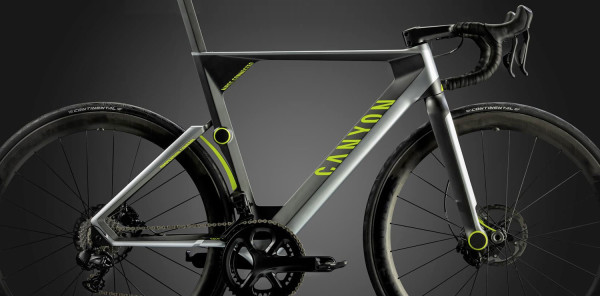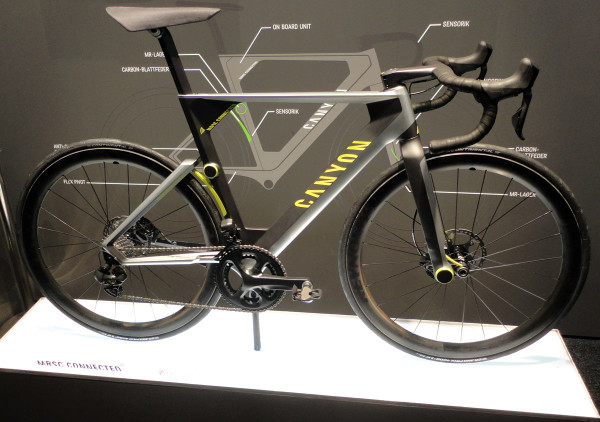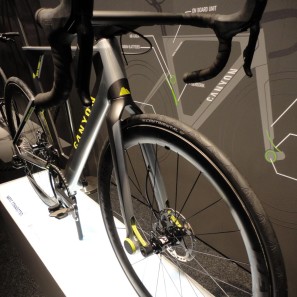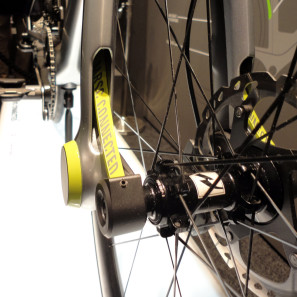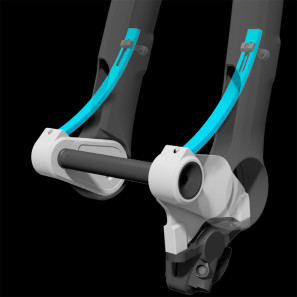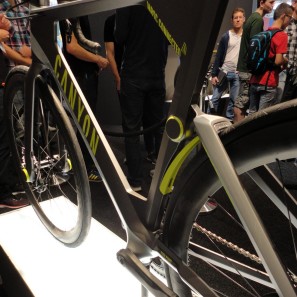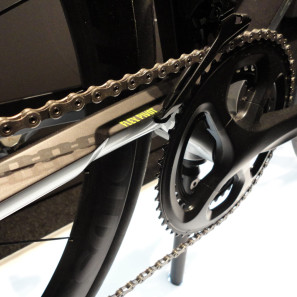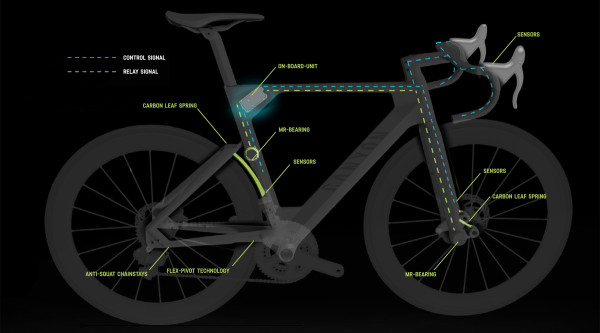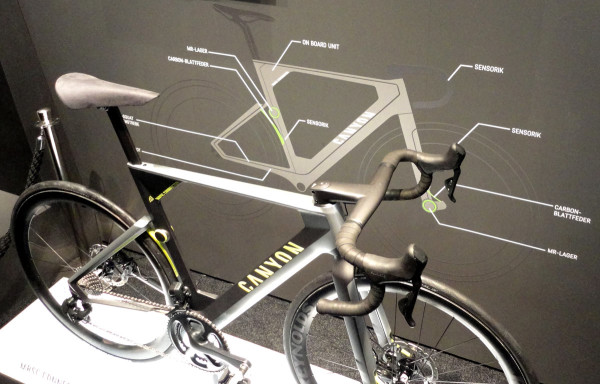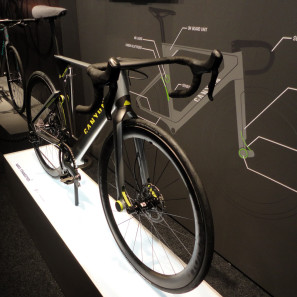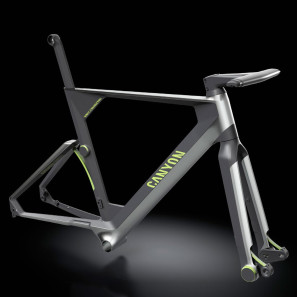In an effort to combat rider fatigue from road surface vibration and ensure all of the cyclist’s energy is put to forward motion, Germany’s Canyon bikes have introduced a smart full-suspension road bike prototype at Eurobike. The concept bike dubbed Projekt MRSC Connected ( for Magneto-Rheological Suspension Control) is a move in the direction to highlight a design focus on comfort, as lightness and stiffness have continue to progress almost exclusively at the high-end. Canyon feels strongly that more comfort means higher performance, and has incorporated their own VCLS Technology (Vertical Comfort, Lateral Stiffness) into their frames for several years. The Projekt MRSC is a next iteration in expanding this tech.
Canyon’s engineering team sees constant road vibration as the next biggest cause of rider fatigue beyond pedaling effort. As the back and leg muscles undergo stress to counteract road impacts and stabilize the bike, rider comfort decreases and with it endurance and speed. The vibration also breaks the bike’s contact with the road and its intended path, consuming unnecessary energy.The MRSC system proposed an active bike frameset to enhance comfort and handling, with less energy input.
Join us after the break for a detailed look at the bike, how it works, and how it stays connected…
The core technology is a carbon leaf-spring suspended bike with MR (magneto-rheological) fluid bearings which change their resistance when subjected to electrical current. These bearings are then controlled by an on-board CPU, effectively being opened up or locked-out, in response to on-board impact, position, and movement sensor feedback. The sensors detect riding conditions and rider inputs to be processed by the CPU and adjust the allowable movement of the suspension elements accordingly. The frameset highlight MR bearings are designed to look sculpted out of the frame, and combine with the leaf springs to be painted in a bright contrasting color to truly stand out.
The base carbon frame takes a lot of design cues from Canyon’s Pro Tour tested Aeroroad CF SLX aero race bike, and uses the same pro geometry of the Ulitmate and Aeroroad lines to maintain a low, aggressively aero riding position.
The fork forgoes the traditional bulky design of suspension forks, which are built around complicated internals, for a simple execution that is more in line with a road race frame. Suspension is handled by two electronically controlled Magneto-Rheological bearings with a small leading arm holding the through axle and post-mount disc brake. It works by utilizing an increased overall fork leg length with an upward and backwards moving axle path that allows the fork to minimize frontal area for a more aerodynamic design.
The rear suspension works on a similar concept to the forks with another electronically controlled Magneto-Rheological bearing connected to a lever inside of the seat tube driven by the seatstay monostay. The rear triangle leaves out a pivot point, instead relying on the carbon chainstays to flex at a specially designed section just behind the bottom bracket like a softtail. Another carbon leaf spring, this time connecting the seattube and monostay, controls suspension action when the bearings are in the open travel position, and provides lateral stiffness.
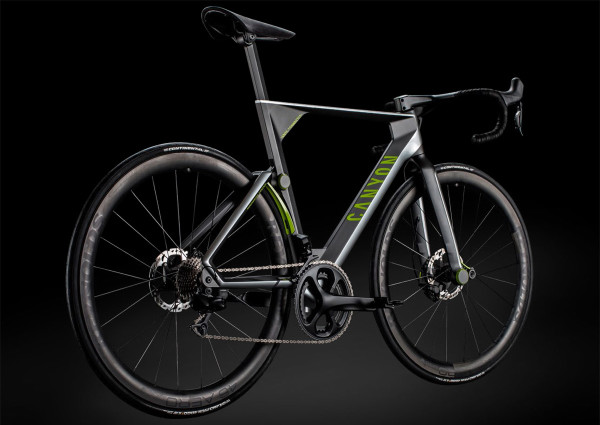
Frameset Design Features:
- 15mm front and 12mm rear through axles for improved stiffness and consistent handling
- hydraulic 160mm front and 140mm rear disc brakes for reliable, powerful braking
- automatically electrically/magnetically controlled fluid in the suspension bearings provided infinite adjustment between fully open and fully locked out suspension movement, based on riding conditions
- pivot-less chainstays to minimize rear end squat and maintain efficient power transfer and handling
- 15mm of axle travel to account for 90% of road vibrations and impacts
- user adjustable curved fork leaf springs to affect suspension character, and maximize travel progression
Connectivity Features:
- on-board CPU tracks consumables and alerts the rider via smartphone when brake pads, chain, and cables need replacing
- a GPS module records location data for training and performance tracking with out any additional electronics
- combined with a GSM connection, it allows the bike to be tracked if stolen
- the tracking system can also allow you to share your location with friends and family to see where you are or meet up
- with the GSM connection the frame’s E-Call can also alert emergency services in case of a serious crash
While the bike is very clearly a concept bike, it might be better described as a proof-of-concept bike. Canyon’s engineers clearly see the spread of electronic integration as the way that bike design is moving forward in the near future. The interconnectivity of bikes with location data gathering and live position access (see all the GPSes on rider bikes these days and Garmin Live Ride Tracking), electronic suspension control (see Lapierre an Ghost’s E:i Shock), and automatic emergency calls (see ICE.) is a real thing now. Upping the ante with this innovative magnetically controlled fluid in the suspension and tying it all together is the next logical step for Canyon.
Sure, we won’t be able to buy this bike next spring like most of the tech we see at Eurobike, but from the way the engineers talk, it may not be so far off. I get the feeling that this bike will continue to develop in their test lab. And I would be surprised if they won’t bring it to market before 2020.
